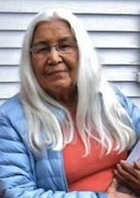
Materials required: iPhone or other recording device, logbook
Read the Peter Paul quote to the students. Then, discuss the word “sovereign”. Ask how Elders or well-respected people in a community can make a community more sovereign – either coming from the people themselves (like Jason Barnaby) or from some spiritual source. Read the passage below as told by Jason Barnaby of Esgenoôpetitj (Skno’pitijk), one of the creators of this resource.
I was able to secure some time with Elder Arthur Bartiboug yesterday. Elder Bartiboug is truly a living historian of our culture, writings (Pacifique dialect), and has truly interesting stories of the past.
I asked him last night, what is a Kinap (gee nup), shaman or medicine man? Women were called Puowin. He told me, in the past, there were Kinap in our community and in most Mi’kmaq communities, but no one ever really directly would know who it was but that they would always be suspicious of who it may be. A Kinap is usually a man with great powers and one story he told me was of a man by the name of Edward in Esgenoôpetitj (Skno’pitijk) before Elder Bartiboug’s time.
Mr. Edward was a forester like many other Mi’kmaw. Many men would work in groups using a buck saw, but Mr. Edward would only work alone and away from everyone else and only used an axe. By lunch time when the men in groups were ready for their noon hour break, Mr. Edward would already be sitting close by, watching the men, no one would ever see him or catch him approaching the men for lunch. The men would always compete between each other about who cut the most wood — Mr. Edward would always have cut two cords by lunch time which is quite a feat working alone with an axe or even working alone today with a power saw. It is said that if anyone would touch Mr. Edward’s axe handle, he would remove it right away and toss it into the fire and replace it with a new handle.
On a personal note, when I was young, Elder Bartiboug was talked about that he may be a Kinap in our community. His great grandmother, who I remember, was a Puowin (shaman). When I was a mischievous boy, I would hit every mailbox on my way home with a rock or a stick, but I would never touch the old lady’s mailbox. There was always lots of talk about Mr. Bartiboug’s grandmother and the stories are still told by the Elders today. Puowin and Kinap, people with these kinds of powers were not necessarily bad people, and I personally believe that myself. Many years later in my life I ended up living in the old lady’s house and remember the first night I slept in her old home as being scared. Remembering the old lady, she came into my dreams that night and reassured me that not to be scared and that things will be ok. True they were. All the years I lived there as a father with my young children we always managed to have great meals and great holidays with my meagre wages.
What were these people — Arthur Bartiboug and his grandmother — famous for? What purpose would they serve in a community even though they were elderly? Does this remind you of Peter Paul’s words? Ask the students if there was someone in their family or community who is famous for some reason? Someone who recalls or who was involved in some activity that was unexplainable?
- In pairs, ask the students to record an interview with that person on an iPhone or with another recording device. If the interview is to be successful there must be some careful groundwork done first (i.e.: compose a list of 10 questions to ask). The interview should be no more than 10 minutes.
- After completing the interview, the students should listen to it again and try telling the story from the interview to the whole class.
- Then have the students write a short biography of their Elder or well-respected person. Include in it the job, hobby, or experience that was particularly influential on their community.
- Design a bulletin board or a display table about your Elder or celebrity. You can use tools, artefacts, finished products, and photos.
- Make a timeline of the celebrity’s life.
- What is one idea from the Elder’s or celebrity’s interview that shows wisdom?
- How does this person make the people in their community more sovereign?
- Discuss: Why is it important to pass along the information about these Elders or well-respected people to those who have never met them?




